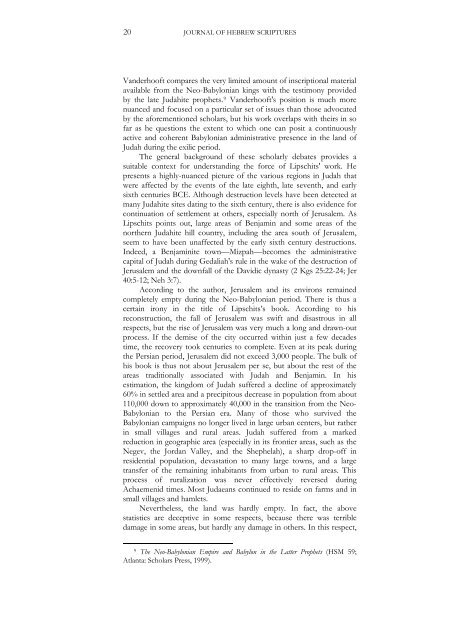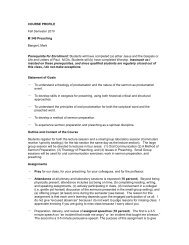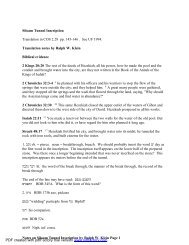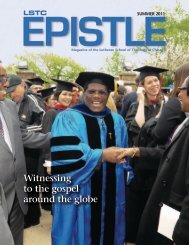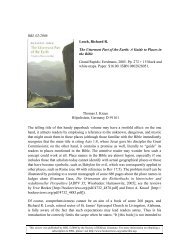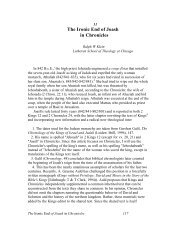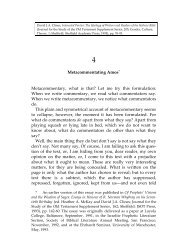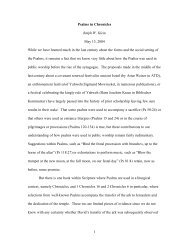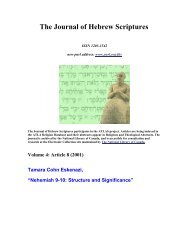Download this PDF file - University of Alberta - Journal Hosting
Download this PDF file - University of Alberta - Journal Hosting
Download this PDF file - University of Alberta - Journal Hosting
Create successful ePaper yourself
Turn your PDF publications into a flip-book with our unique Google optimized e-Paper software.
20JOURNAL OF HEBREW SCRIPTURESVanderho<strong>of</strong>t compares the very limited amount <strong>of</strong> inscriptional materialavailable from the Neo-Babylonian kings with the testimony providedby the late Judahite prophets. 9 Vanderho<strong>of</strong>t's position is much morenuanced and focused on a particular set <strong>of</strong> issues than those advocatedby the aforementioned scholars, but his work overlaps with theirs in s<strong>of</strong>ar as he questions the extent to which one can posit a continuouslyactive and coherent Babylonian administrative presence in the land <strong>of</strong>Judah during the exilic period.The general background <strong>of</strong> these scholarly debates provides asuitable context for understanding the force <strong>of</strong> Lipschits' work. Hepresents a highly-nuanced picture <strong>of</strong> the various regions in Judah thatwere affected by the events <strong>of</strong> the late eighth, late seventh, and earlysixth centuries BCE. Although destruction levels have been detected atmany Judahite sites dating to the sixth century, there is also evidence forcontinuation <strong>of</strong> settlement at others, especially north <strong>of</strong> Jerusalem. AsLipschits points out, large areas <strong>of</strong> Benjamin and some areas <strong>of</strong> thenorthern Judahite hill country, including the area south <strong>of</strong> Jerusalem,seem to have been unaffected by the early sixth century destructions.Indeed, a Benjaminite town—Mizpah—becomes the administrativecapital <strong>of</strong> Judah during Gedaliah's rule in the wake <strong>of</strong> the destruction <strong>of</strong>Jerusalem and the downfall <strong>of</strong> the Davidic dynasty (2 Kgs 25:22-24; Jer40:5-12; Neh 3:7).According to the author, Jerusalem and its environs remainedcompletely empty during the Neo-Babylonian period. There is thus acertain irony in the title <strong>of</strong> Lipschits’s book. According to hisreconstruction, the fall <strong>of</strong> Jerusalem was swift and disastrous in allrespects, but the rise <strong>of</strong> Jerusalem was very much a long and drawn-outprocess. If the demise <strong>of</strong> the city occurred within just a few decadestime, the recovery took centuries to complete. Even at its peak duringthe Persian period, Jerusalem did not exceed 3,000 people. The bulk <strong>of</strong>his book is thus not about Jerusalem per se, but about the rest <strong>of</strong> theareas traditionally associated with Judah and Benjamin. In hisestimation, the kingdom <strong>of</strong> Judah suffered a decline <strong>of</strong> approximately60% in settled area and a precipitous decrease in population from about110,000 down to approximately 40,000 in the transition from the Neo-Babylonian to the Persian era. Many <strong>of</strong> those who survived theBabylonian campaigns no longer lived in large urban centers, but ratherin small villages and rural areas. Judah suffered from a markedreduction in geographic area (especially in its frontier areas, such as theNegev, the Jordan Valley, and the Shephelah), a sharp drop-<strong>of</strong>f inresidential population, devastation to many large towns, and a largetransfer <strong>of</strong> the remaining inhabitants from urban to rural areas. Thisprocess <strong>of</strong> ruralization was never effectively reversed duringAchaemenid times. Most Judaeans continued to reside on farms and insmall villages and hamlets.Nevertheless, the land was hardly empty. In fact, the abovestatistics are deceptive in some respects, because there was terribledamage in some areas, but hardly any damage in others. In <strong>this</strong> respect,9 The Neo-Babylonian Empire and Babylon in the Latter Prophets (HSM 59;Atlanta: Scholars Press, 1999).


